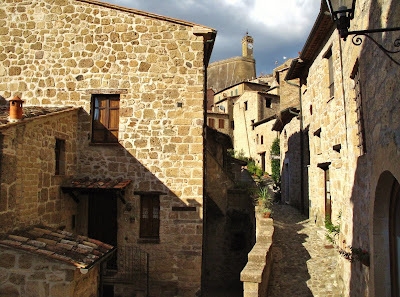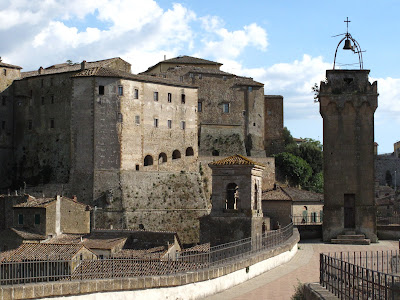Part of the group of three villages that make up the "Città del Tuffo," Sorano is a dramatic, fairy-tale Italian town that is Southern Tuscany's best-kept secret...until now.
 |
| Entrance To The Hotel Castle |
Sorano is my favourite place in all of Italy. Its red-tiled roofs are reminiscent of Siena in northern Tuscany but without the polish and refinement. Sorano doesn't have the history of Rome, the art of Florence, or the serenity of Assisi. Sorano isn't nearly as pretty as the Amalfi Coast or the Cinque Terre, but there is something so bewitching and mysterious about this rustic little Tuscan village. The Città del Tuffo include the towns of Sorano, Sovana and Pitigliano.

The town was considered a "dead" community by the government in 1923. Many of the homes and buildings have slid into the Lente River gorge since 1801. But the Soranese have persisted, and Sorano is making a vibrant comeback in the past decade. I haven't written about this enchanting village or told anyone about Sorano so that I could keep it my secret Tuscan getaway. But now the secret is out-BIG TIME. The Netflix Original Series Luna Nera (Black Moon) has filmed many scenes in Sorano. The Netflix show is based on a book series about a group of 16th-century witches by Italian writer Tiziana Triana. Most of the show is filmed in Rome at the Cinecitta studios and on various locations in Lazio and Southern Tuscany. In the series, Sorano is transformed into the fictitious medieval village of Serra. Look out; season 2 of Luna Nera is filming now!

We ended up in Sorano because my eleven-year-old son practically begged to stay in a "real castle." So then I did my research on castle stays in Tuscany and found Hotel della Fortezza in Sorano. Castle hotels in Italy are quite costly, but the Hotel della Fortessa is an affordable luxury in an authentic piece of Italian medieval history! Everything about this hotel is outstanding; the service, the rooms each with spectacular views, and the complimentary continental breakfast, which includes home-baked cakes and confectionaries. The Fortezza became our home base for exploring the surrounding area like Pitigliano, Sovana, Saturnia and hiking the Vie Cave. Also housed in the Fortress is the Museum of the Middle Ages.
 |
| View Of The Fortress From Masso Leopoldino |
The Hotel della Fortezza sits upon the hill above the village of Sorano and dominates the skyline. Most people coming into Sorano are driving and approach from the SP73 road that has a hairpin turn offering an outstanding view of the entire town, so be sure to pull over to snap a photo! There is a free city parking lot on Via San Marco next to the hotel parking, just follow the signs to Hotel della Fortezza. The views of Sorano below from the hotel rooms are phenomenal! The castle was initially built by the Aldobrandeschi family in the 13th century as a military stronghold. Niccolò Orsini renovated it in 1552 around the same time as he rebuilt the fortress in Pitigliano to defend against the wars with Siena and Orvieto.
 |
| Passageway From The Castle To The Village |
Sorano spread below the castle begs to be explored! You can take a pathway from the fortress down to the village via the arched walkway. This town has been inhabited since the Villanovan people who predate the Etruscan culture. This is evident in the number of caves carved into the tufa rock along the Lente River at the base of Sorano. The Latin name for Sorano was Soranus. This is referring to the village as a "the city of the dead," because all of the columbaria or caves the Romans found. First, these caves were used as a resting place for the ashes of the dead. Later, as the inhabitants moved up the cliffs, and these caves became dwellings, then shelter for livestock. The caves are still used today as storage for farm equipment.
Another commanding feature of Sorano is the Masso Leopoldino. This elevated area was carved from natural tuff stone to form a fortified panoramic terrace. Built in the 17th century, Masso Leopoldino was named after Duke Leopold of Lorraine. The fort was constructed over an existing set of medieval structures to improve the fortified city walls of Sorano. The views from the balcony of Sorano; the Orsini fortress on one side and the Lente river gorge on the other is phenomenal. When enjoying the views from Masso Leopoldino mind your young travellers, there are no extra special guard rails to keep them from tumbling over the edge!

Clinging to the side of Masso Leopoldino is the remnant of Sorano's Jewish Ghetto. Like Pitigliano, Sorano had a substantial Ebraic community after the Jewish people left the Papal lands of Lazio in the late 1500s. Wandering through this maze of pathways leads you to the most magnificent Medieval gate, the Porta dei Merli. Also known as the Porta del Sotto, this massive gate is made of ashlar stone construction from the Lente riverbed and is crowned with an impressive coat of arms.

This path leads down to the Lente River and on into the forest where the trail becomes a mysterious Etruscan pathway called a 'Via Cava.' Every year at dawn on the Spring Equinox, the residents of Sorano hold a candlelight procession from the church above, along this trail to the Lente riverbed.

Another ancient tradition in Sorano involves food. The delicious Sorano ham is known throughout Italy and is celebrated in the first week of August every year during the "Festa of Ham." Also, sample the local sheep milk ricotta cheese and the caciotta with a glass of the delicious local white wine!
Local artisan shops are lined down the main street of the historical centre. Olive oil, leather items and olive wood products from Sorano are highly prized. There is a fantastic woodcarving shop called "La Bottega Del Lengo" just past the historic centre city gate, called the Porta di Sopra. Follow the street from Sorano's panoramic Piazza Pietro Del Lengo through the city gate, and the shop is just beyond on Via Giovanni Selvi #4. La Bottega Del Lengo makes fantastic olive wood cutting boards, utensils & household items, even jewelry!

Honestly, the best part of Sorano is just wandering around the village and taking in the views of the red-tiled roofs, ancient stonework and soaking in the rustic atmosphere. Get lost amongst the labyrinth of alleyways, staircases and underpasses that give Sorano that medieval atmosphere.
Don't forget to visit all the friendly cats! 😻




No comments:
Post a Comment